Μια άλλη περιγραφή όλων των εργαλείων είναι εδώ.
Λειτουργίες
Προσθήκη συμπλεγμάτων: Κάντε κλικ στο LMB για να προσθέσετε ένα κέντρο συμπλέγματος (Νησιά UV ) απευθείας σε μια όψη πολυγώνου. Κάνοντας ξανά κλικ στο ίδιο πρόσωπο θα το αφαιρέσετε. Αυτό το εργαλείο σάς επιτρέπει να “σημαδεύετε” μια ραφή χωρίς να την επισημαίνετε ως μία, επιτρέποντας σε ένα ολόκληρο νησί UV να χωριστεί σε μέρη χωρίς να τα χωρίσει πραγματικά.
Mark Sems: Όταν είστε έτοιμοι να ξετυλίξετε το πλέγμα σας για να δημιουργήσετε έναν χάρτη UV , πρέπει να επιλέξετε τις ραφές σας. Εκεί μπαίνει αυτό το εργαλείο. Μπορείτε να επιλέξετε άκρες με το LMB, βρόχους άκρων με SHIFT+LMB και να αποεπιλέξετε με CTRL+LMB.
Βρόχοι άκρων: Αυτό το εργαλείο δεν διαφέρει από το να κρατάτε πατημένο το SHIFT+LMB με το εργαλείο “Σήμανση ραφών”. Η διαφορά είναι ότι δεν απαιτείται να κρατήσετε πατημένο το πλήκτρο SHIFT για να επιλέξετε τους βρόχους άκρων που θέλετε. Χρησιμοποιήστε LMB για να επισημάνετε βρόχους άκρων, όπως ραφές υφής, ή καταργήστε τη σήμανση χρησιμοποιώντας CTRL+LMB.
Διαδρομή UV : Επιτρέπει την επιλογή των κορυφών που ερμηνεύονται από το 3DCoat για να παρέχει τη διαδρομή για μια συνδεδεμένη σειρά άκρων που επισημαίνονται ως ραφές ξετυλίγματος. Βάλτε μια διαδρομή κατά μήκος της συντομότερης διαδρομής (υπό ορισμένα κριτήρια) μεταξύ πολλών σημείων. Κάντε κλικ για να προσθέσετε σημεία ή διαχωρισμό γραμμών, χρησιμοποιήστε RMB ή κάντε διπλό κλικ για να αφαιρέσετε σημεία. Πατήστε ENTER για να επισημάνετε τις ραφές και CTRL ENTER για να διαγράψετε τις ραφές. Χρησιμοποιήστε διαφορετικά κριτήρια για να προσαρμόσετε τη ροή διαδρομής.
Σύνδεση συστάδων: Τοποθετήστε το δείκτη της ραφής μεταξύ των συμπλεγμάτων και κάντε κλικ για να αφαιρέσετε ολόκληρη τη ραφή και να ενώσετε τα συμπλέγματα.
Εάν οι επισημασμένες ραφές είναι κόκκινες, τα νησιά σύνοψης που προκύπτουν έχουν αυτοτομές ή πολύ μεγάλα τετράγωνα σκουπίδια. Εάν είναι πράσινο, το συνοπτικό νησί δεν έχει αυτοδιασταυρώσεις και τα τετράγωνα σκουπίδια δεν είναι περισσότερο από το 1/2.
Επιλεγμένο
Στον επάνω πίνακα, μπορείτε να επιλέξετε τύπους επιλογής:
Κορυφές, άκρες, πρόσωπα, νησιά, Brush και τσιμπήματα.

Επιλέξτε κορυφές, άκρες ή όψεις (ανάλογα με τον τύπο που έχετε επιλέξει) με LMB. Εάν κρατήσετε πατημένο το LMB και σύρετε το ποντίκι, μπορείτε να επιλέξετε πολλές κορυφές/άκρες/πρόσωπα. Χρησιμοποιήστε το SHIFT για να προσθέσετε ένα στοιχείο στην επιλογή και χρησιμοποιήστε το CTRL για να αφαιρέσετε ένα στοιχείο από την επιλογή.
Ανάλογα με τον τύπο επιλογής, οι λειτουργίες στο επιλεγμένο μπλοκ ενδέχεται να αλλάξουν.
νησιά
Clear: Διαγράφει την επιλογή.
Invert: αντιστρέφει την επιλογή.
Rotate CW: Αυτό θα περιστρέψει το επιλεγμένο νησί δεξιόστροφα.
Περιστροφή CCW: Αυτό θα περιστρέψει το επιλεγμένο νησί αριστερόστροφα.
Αναστροφή U: Αυτό θα ανατρέψει το U του χάρτη UV .
Αναστροφή V: Αυτό θα αναποδογυρίσει το V του χάρτη UV .
Relax: Εφαρμόζει ελαφριά εξομάλυνση σε όλο το επιλεγμένο σύμπλεγμα (ή νησί) για να ανακουφίσει το τέντωμα ή το τσίμπημα.
Cloth Relax: Χαλαρώστε τα νησιά UV έτσι ώστε οι απέναντι άκρες στις ραφές να έχουν σχεδόν το ίδιο μήκος και την ίδια σχέση μεταξύ του μήκους των άκρων στο διάστημα και του μήκους των άκρων στο χώρο UV . Αυτό μπορεί να είναι χρήσιμο για την κατασκευή πραγματικών πραγμάτων – υφασμάτων και μαλακών παιχνιδιών.
To ABF: Η νεότερη, πιο προηγμένη μορφή ξετυλίγματος που ταιριάζει καλύτερα για οργανικά πλέγματα.
To Globally Uniform (UV) ξετύλιγμα: Ξετυλίξτε επιλεγμένα νησιά με την αποκλειστική μέθοδο ξετυλίγματος Globally Uniform UV της 3DCoat.
Προς LSCM: Η παλαιότερη, πιο παραδοσιακή μορφή Unwrapping, η οποία μπορεί να είναι πιο συμβατή με εξωτερικές εφαρμογές 3D.
To Planar: Χρησιμοποιεί την επίπεδη προβολή για το ξετύλιγμα των επιλεγμένων νησιών UV .
To Strip: Αυτή η μέθοδος προορίζεται να ξετυλίξει τη λωρίδα των πολυγώνων σε μια ευθεία γραμμή.
Απόκρυψη: Απόκρυψη επιλεγμένων προσώπων.
Inv. Κρυμμένος:
Unhide: Αντιστροφή κρυφών προσώπων.
Unhide all: Unhide all hidden faces.
HD Expand: Επέκταση της κρυφής περιοχής.
HD Contract: Συμβόλαιο κρυφή περιοχή.
Αντιγραφή UV: Αντιγραφή νησίδας στο πρόχειρο (χρησιμοποιήστε CTRL+C). Μπορείτε να επιλέξετε ένα άλλο νησί και να το επικολλήσετε εκεί. Με αυτόν τον τρόπο, θα βάλετε ακριβώς ένα νησί πάνω από ένα άλλο.
Επικόλληση UV: Επικολλήστε το νησί UV που είχε αντιγραφεί προηγουμένως. Πρέπει να επιλέξετε ένα νησί, να πατήσετε CTRL+C, μετά να επιλέξετε ένα άλλο νησί που έχει την ίδια τοπολογία και να πατήσετε CTRL+V. Με αυτόν τον τρόπο, θα βάλετε ακριβώς το πρώτο νησί πάνω από το δεύτερο.
Ακρα
Στη λειτουργία επιλογής άκρων, υπάρχουν μερικά εργαλεία.
Είναι: Σε ευθεία, Ισαπέχουσα, Οριζόντια και Κατακόρυφη.
Σημείωση: μπορείτε να επιλέξετε έναν βρόχο άκρης κάνοντας διπλό κλικ στην άκρη ή μπορείτε απλώς να χρησιμοποιήσετε μια εντολή Edgeloop στο επιλεγμένο μπλοκ. Με την εντολή Edgering, μπορείτε να επιλέξετε δακτυλίους ακμών.
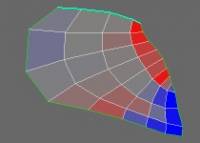
Η εντολή To line τοποθετεί όλες τις επιλεγμένες άκρες κατά μήκος της γραμμής.
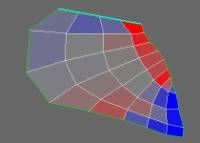
Η εντολή Equidistant τοποθετεί όλες τις επιλεγμένες ακμές κατά μήκος της γραμμής και ορίζει ίση απόσταση μεταξύ των σημείων.
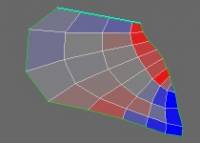
Η εντολή οριζόντια τοποθετεί όλες τις επιλεγμένες άκρες οριζόντια.
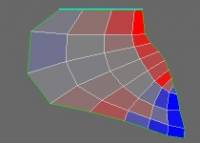
Η κάθετη εντολή τοποθετεί όλες τις επιλεγμένες άκρες κάθετα.

Clear: Διαγράφει την επιλογή.
Invert: αντιστρέφει την επιλογή.
Rotate CW: Αυτό θα περιστρέψει το επιλεγμένο νησί δεξιόστροφα.
Περιστροφή CCW: Αυτό θα περιστρέψει το επιλεγμένο νησί αριστερόστροφα.
Αναστροφή U: Αυτό θα ανατρέψει το U του χάρτη UV .
Αναστροφή V: Αυτό θα αναποδογυρίσει το V του χάρτη UV .
Προς γραμμή: Τοποθετήστε τις επιλεγμένες άκρες κατά μήκος της γραμμής.
Ισοαπόσταση: Τοποθετήστε επιλεγμένες άκρες κατά μήκος της γραμμής και ορίστε ίση απόσταση μεταξύ των σημείων.
Οριζόντια: Βάλτε άκρες κατά μήκος των οριζόντιων γραμμών.
Κάθετη: Τοποθετήστε άκρες κατά μήκος της κάθετης γραμμής.
Βρόχος άκρων: Επιλέξτε βρόχο άκρης (στο παράθυρο προεπισκόπησης UV ).
Edge Ring: Επιλέξτε τον δακτύλιο ακμής (στο παράθυρο προεπισκόπησης UV ).
Ορισμός ραφών: Επισημαίνει επιλεγμένες άκρες ως ραφές.
Διαγραφή ραφών: Διαγράψτε τις ραφές σε επιλεγμένες άκρες (στο παράθυρο προεπισκόπησης UV ).
Πρόσωπα
Η λειτουργία επιλογής προσώπων διαφέρει από τη λειτουργία επιλογής Vertices σε πρόσθετες εντολές:
Χρησιμοποιήστε αυτές τις εντολές για να εμφανίσετε μόνο επιλεγμένα πρόσωπα στη θύρα προβολής.
Clear: Διαγράφει την επιλογή.
Invert: αντιστρέφει την επιλογή.
Rotate CW: Αυτό θα περιστρέψει το επιλεγμένο νησί δεξιόστροφα.
Περιστροφή CCW: Αυτό θα περιστρέψει το επιλεγμένο νησί αριστερόστροφα.
Αναστροφή U: Αυτό θα ανατρέψει το U του χάρτη UV .
Αναστροφή V: Αυτό θα αναποδογυρίσει το V του χάρτη UV .
Relax: Εφαρμόζει ελαφριά εξομάλυνση σε όλο το επιλεγμένο σύμπλεγμα (ή νησί) για να ανακουφίσει το τέντωμα ή το τσίμπημα.
Cloth Relax: Χαλαρώστε τα νησιά UV έτσι ώστε οι απέναντι άκρες στις ραφές να έχουν σχεδόν το ίδιο μήκος και την ίδια σχέση μεταξύ του μήκους των άκρων στο διάστημα και του μήκους των άκρων στο χώρο UV . Αυτό μπορεί να είναι χρήσιμο για την κατασκευή πραγματικών πραγμάτων – υφασμάτων και μαλακών παιχνιδιών.
Απόκρυψη: Απόκρυψη επιλεγμένων προσώπων.
Inv. Κρυφό: Αντιστροφή κρυφών προσώπων.
Unhide: Αντιστροφή κρυφών προσώπων.
Unhide all: Unhide all hidden faces.
HD Expand: Επέκταση της κρυφής περιοχής.
HD Contract: Συμβόλαιο κρυφή περιοχή.
Κορυφές
Όλες οι άλλες εντολές λειτουργούν με τον ίδιο τρόπο όπως για το Vertices.
νησιά
Η λειτουργία επιλογής νησιών σάς επιτρέπει να λειτουργείτε με ξεχωριστά νησιά UV . Μπορείτε να μεταφράσετε, να περιστρέψετε και να κλιμακώσετε (κάθετα, οριζόντια και αναλογικά) ένα νησί με τη βοήθεια ενός χειριστή.

Σημειώστε ότι πρέπει να ενεργοποιήσετε τον χειριστή στην επάνω γραμμή. Επιλέξτε τα πλαίσια ελέγχου Επιλογή και χειρισμός.
Συμβουλή: Διατηρείτε πάντα επιλεγμένο το πλαίσιο ελέγχου Επιλογή, εκτός εάν δεν θέλετε να επιλέξετε τίποτα.
Clear: Διαγράφει την επιλογή.
Invert: αντιστρέφει την επιλογή.
Rotate CW: Αυτό θα περιστρέψει το επιλεγμένο νησί δεξιόστροφα.
Περιστροφή CCW: Αυτό θα περιστρέψει το επιλεγμένο νησί αριστερόστροφα.
Αναστροφή U: Αυτό θα ανατρέψει το U του χάρτη UV .
Αναστροφή V: Αυτό θα αναποδογυρίσει το V του χάρτη UV .
Relax: Εφαρμόζει ελαφριά εξομάλυνση σε όλο το επιλεγμένο σύμπλεγμα (ή νησί) για να ανακουφίσει το τέντωμα ή το τσίμπημα.
Cloth Relax: Χαλαρώστε τα νησιά UV έτσι ώστε οι απέναντι άκρες στις ραφές να έχουν σχεδόν το ίδιο μήκος και την ίδια σχέση μεταξύ του μήκους των άκρων στο διάστημα και του μήκους των άκρων στο χώρο UV . Αυτό μπορεί να είναι χρήσιμο για την κατασκευή πραγματικών πραγμάτων – υφασμάτων και μαλακών παιχνιδιών.
To ABF: (Angle Based Flattening). Το ABF είναι ένας νεότερος αλγόριθμος ξετυλίγματος που είναι ο καταλληλότερος για οργανικά πλέγματα.
Προς GU: Ξετυλίξτε επιλεγμένα νησιά με την αποκλειστική μέθοδο ξετυλίγματος Globally Uniform UV της 3DCoat.
Προς LSCM: (Last Squares Conformal Maps) Η παλαιότερη, πιο παραδοσιακή μορφή Unwrapping, η οποία μπορεί να είναι πιο συμβατή με εξωτερικές εφαρμογές 3D.
Προς επίπεδη: Χρησιμοποιεί την επίπεδη προβολή για το ξετύλιγμα των επιλεγμένων νησιών UV κατά μήκος του αυθαίρετου άξονα.
To Strip: Αυτή η μέθοδος προορίζεται να ξετυλίξει τη λωρίδα των πολυγώνων σε μια ευθεία γραμμή.
Απόκρυψη: Απόκρυψη επιλεγμένων προσώπων.
Inv. Κρυφό: Αντιστροφή κρυφών προσώπων.
Unhide: Αντιστροφή κρυφών προσώπων.
Unhide all: Unhide all hidden faces.
HD Expand: Επέκταση της κρυφής περιοχής.
HD Contract: Συμβόλαιο κρυφή περιοχή.
Αντιγραφή UV: Αντιγραφή νησίδας στο πρόχειρο (χρησιμοποιήστε CTRL+C). Μπορείτε να επιλέξετε ένα άλλο νησί και να το επικολλήσετε εκεί. Με αυτόν τον τρόπο, θα βάλετε ακριβώς ένα νησί πάνω από ένα άλλο.
Επικόλληση UV: Επικολλήστε το νησί UV που είχε αντιγραφεί προηγουμένως. Πρέπει να επιλέξετε ένα νησί, να πατήσετε CTRL+C, μετά να επιλέξετε ένα άλλο νησί που έχει την ίδια τοπολογία και να πατήσετε CTRL+V. Με αυτόν τον τρόπο, θα βάλετε ακριβώς το πρώτο νησί πάνω από το δεύτερο.
Λειτουργία πινέλων
Σε αυτήν τη λειτουργία, λειτουργείτε με το πινέλο, του οποίου το μέγεθος και αλλάζει κρατώντας πατημένο το RMB και μετακινώντας το ποντίκι στην άκρη.
Μπορείτε να χειριστείτε το πλέγμα κάτω από το πινέλο με το LMB κλικ και σύρετε. Χρησιμοποιήστε SHIFT+LMB για να εξομαλύνετε το πλέγμα. Χρησιμοποιήστε CTRL+LMB για να τσιμπήσετε την περιοχή κάτω από τη βούρτσα. Χρησιμοποιήστε SHIFT+CTRL+LMB για να επεκτείνετε την περιοχή κάτω από τη βούρτσα.
Μικροδιόρθωση
Η τελευταία λειτουργία είναι το Tweak. Επιτρέπει τη μεταφορά κορυφών, άκρων ή προσώπων με πολύ εύκολο τρόπο. Απλώς μετακινήστε τον κέρσορα πάνω από μια κορυφή/άκρη/πρόσωπο μέχρι να τονιστεί και, στη συνέχεια, σύρετέ τον με LMB.
Το πλέγμα μπορεί να εμφανιστεί με έναν από τους τρεις τρόπους: χωρίς πούλι, με απλό πούλι και με σύνθετο πούλι.

Είναι πολύ χρήσιμο καθώς δείχνει τις παραμορφώσεις της υφής σε διάφορες περιοχές του πλέγματος.
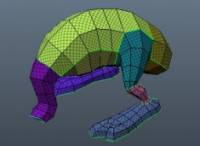
Μια άλλη αναπτυσσόμενη λίστα στα αριστερά της επάνω γραμμής είναι το Choose a UV-set list. Εάν το πλέγμα έχει πολλαπλές UVs, μπορείτε να τις αλλάξετε σε αυτήν την αναπτυσσόμενη λίστα.

Επικαλυπτόμενες υπεριώδεις UVs. Μπορείτε να έχετε επικαλυπτόμενες UVs εντός του 3DCoat χωρίς να προκύψουν προβλήματα. Όπως φαίνεται στην εικόνα.
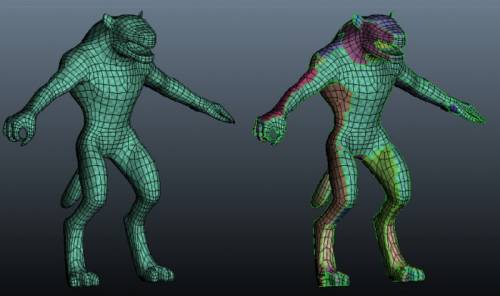
Χρήση χειριστή
(Ο χειριστής λειτουργεί με τον ίδιο τρόπο για κορυφές, ακμές και όψεις)
Πρέπει να πατήσετε Upd. Εντολή Islands για ενημέρωση του παραθύρου προεπισκόπησης UV μετά από λειτουργίες με νησιά UV .
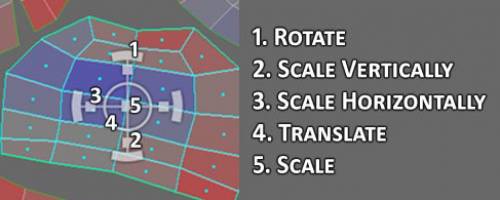
Εντολές
Ρυθμίσεις UV : Ρυθμίστε την περιοχή συσκευασίας του νησιού και την ελάχιστη απόσταση μεταξύ των νησιών.
Clear clusters: Καθαρίζει όλα τα UV cluster (ονομάζονται επίσης UV Islands) και τις ραφές.
Καθαρές ραφές: Καθαρίζει μόνο τις ραφές του τρέχοντος πλέγματος.
Αυτόματες ραφές: Κάνοντας κλικ σε αυτήν την επιλογή δημιουργούνται αυτόματα όλες οι απαιτούμενες ραφές, χρησιμοποιώντας μια προσέγγιση βέλτιστης εικασίας με βάση το σχήμα του αντικειμένου. Οι ραφές που δημιουργήθηκαν πρόσφατα μπορούν ακόμα να επιλεχθούν ή να αφαιρεθούν χρησιμοποιώντας τη λειτουργία εργασίας “Επισήμανση ραφών”. Ουσιαστικά θα δημιουργήσει ραφές αυτόματα με μια “καλύτερη εικασία” για το ποιες άκρες θα επιλέξετε ως ραφές.
Αιχμηρές ραφές: Ρυθμίστε τις ραφές ανάλογα με τη γωνία μεταξύ των προσώπων. Είναι χρήσιμο για UV mapping σκληρών επιφανειών.
Unify UV: Μετακινήστε όλα τα πρόσωπα στο τρέχον σετ UV . Εάν χρειάζεται, διαγράψτε τα υπόλοιπα κενά σετ UV χρησιμοποιώντας το “Delete unused UV-Sets”.
Ξετύλιγμα: Ταιριάζει σε όλα τα συμπλέγματα στον χώρο UV .
AutoMap: Αυτή είναι η ίδια μέθοδος ξετυλίγματος που χρησιμοποιείται στο παράθυρο διαλόγου import για αυτόματη αντιστοίχιση. Είναι επίπεδη mapping με δοκιμή αυτο-τομής συστάδων. Αυτή η μέθοδος είναι η πιο σταθερή και τρώει οποιαδήποτε (ακόμη και μη πολλαπλή) γεωμετρία, αλλά δημιουργεί πάρα πολλά νησιά.
Συσκευασία UV: Αυτό θα συσκευάσει όλα τα αποτυλιγμένα συμπλέγματα UV στον χάρτη UV , σύμφωνα με ένα οδηγό “ορθογώνιο”, το οποίο ορίζετε εσείς. Μπορείτε να επεξεργαστείτε τα νησιά στον χάρτη UV όταν ολοκληρωθεί αυτή η λειτουργία. Σε αυτό το σημείο, μπορείτε να εκτελέσετε πολλές βασικές λειτουργίες που απαιτούν έναν χάρτη UV .
Ανακάτεμα/Συσκευασία: Συσκευάστε το τρέχον σύνολο νησιών UV στο σετ UV . τα επικαλυπτόμενα νησιά θα ανακατευτούν. Δεν πραγματοποιείται ξετύλιγμα. θα γίνει μόνο η συσκευασία.
PackUV2: Συσκευάστε τα νησιά UV χωρίς περιστροφή και ανατροπή. Θα κλιμακωθούν και θα μετακινηθούν μόνο για καλύτερη συσκευασία. Πατήστε CTRL για τυχαία αναπαραγωγή.
Αυτόματη κλίμακα: Αυτόματη κλίμακα σε όλα τα νησιά για να έχουν ίση αναλογία μεταξύ τετραγώνου στο διάστημα και τετραγώνου σε σύνολο UV.
Ενημέρωση νησιών: Όταν έχετε ένα υπάρχον νησί και επισημάνετε περαιτέρω μια ραφή σε αυτό το νησί, με αποτέλεσμα να γίνει δύο, θα πρέπει να εκτελέσετε την εντολή “Update Islands” για να μεταφέρετε αυτές τις πληροφορίες στον πίνακα προεπισκόπησης UV , ώστε να έχετε στη συνέχεια αυτά τα δύο νησιά UV με δυνατότητα επιλογής, στον Πίνακα προεπισκόπησης UV .
Ενημερώστε τη συνδεσιμότητα του νησιού. Εάν έχετε σημειώσει ή σβήσει πολλές ραφές στο πλέγμα, το UV-Map δεν θα σπάσει αμέσως σε νησίδες. Πρέπει να ενημερώσετε τα νησιά για να χωρίσετε ή να συνδέσετε υπάρχοντα νησιά.
Επαναφορά UV: Επαναφέρετε τις UVs από το πλέγμα στο δωμάτιο Paint. Αυτό συγχρονίζει και τα δύο δωμάτια.
Εφαρμογή σετ UV: Εφαρμόζει το τρέχον σχήμα ξετυλίγματος στο τρέχον πλέγμα Retopo .
Αποθήκευση: Αποθήκευση πληροφοριών UV σε ένα αρχείο. Αυτή η επιλογή αποθηκεύει τις επισημασμένες ή μη πληροφορίες ραφής και συμπλέγματος στην τρέχουσα σκηνή, ώστε να είναι δυνατή η επεξεργασία τους αργότερα. Δεν export τον τελικό χάρτη UV. Χρησιμοποιήστε το διάλογο «Import/ Export υφών» στο μενού Αρχείο.
Φόρτωση: Φορτώστε προηγουμένως αποθηκευμένες πληροφορίες UV από ένα αρχείο.
Save contour: Αυτή η εντολή επιτρέπει την αποθήκευση του περιγράμματος σε πραγματική κλίμακα ως EPS ή DXF για περαιτέρω κοπή με λέιζερ. Το μήκος των γραμμών αντιστοιχεί στο γεωμετρικό μήκος. Είναι χρήσιμο εάν θέλετε να κόψετε σχήματα χρησιμοποιώντας τον κόφτη λέιζερ και να κολλήσετε εξαρτήματα μεταξύ τους.
 Ελληνικά
Ελληνικά  English
English Українська
Українська Español
Español Deutsch
Deutsch Français
Français 日本語
日本語 Русский
Русский 한국어
한국어 Polski
Polski 中文 (中国)
中文 (中国) Português
Português Italiano
Italiano Suomi
Suomi Svenska
Svenska 中文 (台灣)
中文 (台灣) Dansk
Dansk Slovenčina
Slovenčina Türkçe
Türkçe Nederlands
Nederlands Magyar
Magyar ไทย
ไทย हिन्दी
हिन्दी Tiếng Việt
Tiếng Việt Lietuviškai
Lietuviškai Latviešu valoda
Latviešu valoda Eesti
Eesti Čeština
Čeština Română
Română Norsk Bokmål
Norsk Bokmål